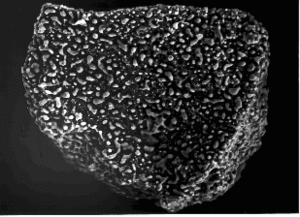Difference between revisions of "Ilmenite Reduction"
Jarogers2001 (talk | contribs) (Carbothermal Reduction Placeholder) |
(→Carbothermal Reduction: Starter info) |
||
| Line 20: | Line 20: | ||
<BR/> | <BR/> | ||
==Carbothermal Reduction== | ==Carbothermal Reduction== | ||
| + | |||
| + | Oxygen can be retrieved from [[Ilmenite]] and [[Rutile]] by means of carbothermal reduction. In experiments, powdered [[carbon]] and powdered ilmenite were evenly mixed and then heated. The end products of this reaction are Oxygen and a super alloy of [[iron|Iron (Fe)]] and Titanium Carbide (TiC) which has a high chemical stability. While this method provides a means of retrieving all of the oxygen from ilmenite and a potential of producing high strength materials lunar regolith, it is at the cost of highly valuable carbon needed for biological processes. | ||
{| cellpadding="10" style="border-style:none;border-width:0px" | {| cellpadding="10" style="border-style:none;border-width:0px" | ||
| style="border-style:dashed; border-width:1px; border-color:#36648B; background:#F0F8FF;" | '''Please note:'''<br> | | style="border-style:dashed; border-width:1px; border-color:#36648B; background:#F0F8FF;" | '''Please note:'''<br> | ||
This section is a placeholder for work currently in progress.<br>-- [[User:Jarogers2001|Jarogers2001]] 16:17, 26 May 2008 (UTC) | This section is a placeholder for work currently in progress.<br>-- [[User:Jarogers2001|Jarogers2001]] 16:17, 26 May 2008 (UTC) | ||
|} | |} | ||
| + | |||
==Other Methods of Ilmenite reduction== | ==Other Methods of Ilmenite reduction== | ||
Carbothermal reduction of Ilmenite<BR/> | Carbothermal reduction of Ilmenite<BR/> | ||
Revision as of 09:28, 31 May 2008
| This article is incomplete or needs more information. You can help Lunarpedia by expanding or correcting it. |
Reduction of ilmenite (FeTiO3) is a chemical reaction proposed for use in production of oxygen (LUNOX) from lunar resources.
Contents
Hydrogen Reduction
Hydrogen reduction is one method currently being tested by many Universities. Products of the hydrogen reduction are free iron, titanium dioxide, and water. The resulting water can be removed by condensation and separated via electrolysis to produce oxygen and H2 (hydrogen). The hydrogen is then be recycled into the reaction.
The basic process sequence is to separate ilmenite from lunar soil, crush it to a fine powder to maximize the surface area, heat the ilmenite in an enclosed reaction vessel in the presence of hydrogen gas, condense the steam which is produced by the reaction, and then use electrolysis to separate the water into hydrogen and oxygen. The process is best utilized if the plant is sited in a location in which ilmenite composes a high fraction of the soil.
The reaction sequence is:
Reduction:
FeTiO3+H2 ---->Fe+TiO2+H2O
Electrolysis:
2H2O ---->2 H2+ O2
Net Reaction:
2FeTiO3---->2Fe+2TiO2+ O2
Carbothermal Reduction
Oxygen can be retrieved from Ilmenite and Rutile by means of carbothermal reduction. In experiments, powdered carbon and powdered ilmenite were evenly mixed and then heated. The end products of this reaction are Oxygen and a super alloy of Iron (Fe) and Titanium Carbide (TiC) which has a high chemical stability. While this method provides a means of retrieving all of the oxygen from ilmenite and a potential of producing high strength materials lunar regolith, it is at the cost of highly valuable carbon needed for biological processes.
| Please note: This section is a placeholder for work currently in progress. |
Other Methods of Ilmenite reduction
Carbothermal reduction of Ilmenite
Li or Na reduction of Ilmenite
Methane reduction of Ilmenite
Plasma reduction of Ilmenite
External Links
- ISRU on the Moon. by Larry Taylor http://www.lpi.usra.edu/lunar_knowledge/LTaylor.pdf
- Extraction Techniques-Oxygen. G. L. Kulcinski, February 18, 2004 http://fti.neep.wisc.edu/neep533/SPRING2004/lecture13.pdf
- Processing Lunar Soils for Oxygen and Other Materials. Knudsen & Gibson http://nss.org/settlement/nasa/spaceresvol3/plsoom1.htm
- Lunar Oxygen Production - A Maturing Technology







